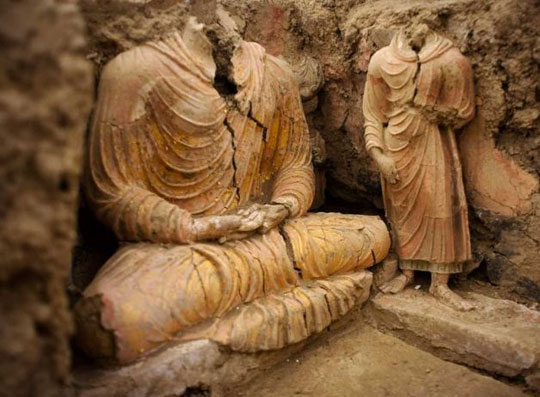Exploiting copper, discovering an ancient monastery 2,600 years
Archaeologists have three years to save this ancient ruin, before it becomes crumbling debris beneath the mines.
Incidentally, a Chinese mining company exploited a copper mine in Afghanistan. They found an ancient Buddhist monument that was 2,600 years old compared to today.

The site was discovered when miners from the Afghan government cooperated with China's Metallurgical Group Corp to carry out a copper mining project. The two sides wish to develop the second largest copper mine in the world under the ruins of the ancient monastery mentioned above.
Knowing about this discovery, archaeologists flocked to make the utmost rescue efforts for ancient ruins believed to exist from seven centuries BC - along the Asian Silk Road. and the Middle East.
Monuments, including monasteries and stupas, were destroyed. It is thought that damage occurs when mining is started. The government allowed archaeologists three years to save the monument.
The above unearthed Convent complex includes walkways, monastery rooms decorated with frescoes and clay Buddha sculptures standing or lying, among them a picture higher than 3 meters.
There is also an area that scientists thought was a yard decorated with a tower as high as 4 or 5 meters. So far, more than 150 statues have been found, and in fact, there are still many more. The archaeological team had a hard time moving the large statues found. Meanwhile, they also lack the chemicals used to make small figurines so they don't crack when moving.
" This archaeological site is very big, it takes 10 years to save this relic, " said Laura Tedesco , an archaeologist from the US Embassy who is involved in archaeological excavations. " Three years can only be enough for the time of statistics and storage of documents about this monument ."
Meanwhile, Philippe Marquis , a French archaeologist, said rescue efforts are being done very little and minimal, due to lack of funding and personnel.
The team hopes to bring a number of large sculptures and some temples out before the winter comes this month, but they still don't have a crane and other heavy-duty loading equipment. .
About 15 Afghan archaeologists, three French advisors and some miners are working in this 2-kilometer-wide area. This is a much more modest amount of manpower than the standard needed to work in a rich and rich area of archaeological resources like this.
Meanwhile, " this is probably one of the most important landmarks along the Silk Road, " Marquis said. " What we have in this monument is enough to enrich and fully stock relics of the national museum of Afghanistan ."
This site is found in Mes Aynak area, a meeting point of archaeological and economic interests in Afghanistan. This area is known to be rich in copper resources. Afghan archaeologists since the 1960s are aware of the role and meaning of Mes Aynak in history. But so far they have not done any excavations.
Some pictures of ongoing excavations:







- Detected 34kg of ancient copper coins dating back thousands of years
- 'City of the dead' in the Syrian desert
- Discovered 2,000-year bronze drum in Ha Tinh
- Discovered two stone bronze casting molds dating back more than 2,000 years
- The whip revealed the monastic life in the Black Death pandemic
- Sensors detect copper in the body
- World copper reserves are sufficient for 100 years
- Detecting copper axes, stone axes of 2,000-3,000 years old in Nghe An
- Unexpectedly found fossil ancient sea monsters when exploiting gems
- Discovering a hundred million year old crater in Quang Ngai
- China unearthed the ancient bronze mirror manufacturing workshop
- Tushilumpo Monastery - A marvelous architecture of Tibet
 Discovered an ancient centipede fossil 99 million years old
Discovered an ancient centipede fossil 99 million years old Discovered bat-like dinosaurs in China
Discovered bat-like dinosaurs in China Discovered a 200-year-old bronze cannon of the coast
Discovered a 200-year-old bronze cannon of the coast Discover 305 million-year-old spider fossils
Discover 305 million-year-old spider fossils Ruins of an ancient temple dating back to the Ptolemaic period discovered in Egypt
Ruins of an ancient temple dating back to the Ptolemaic period discovered in Egypt  Prehistoric vestiges discovered in Dak Nong through archaeological excavations
Prehistoric vestiges discovered in Dak Nong through archaeological excavations  Archaeologists unearth 'thousand year game' in Oman
Archaeologists unearth 'thousand year game' in Oman  Found a slave room buried for 2,000 years under volcanic ash
Found a slave room buried for 2,000 years under volcanic ash  A 5-star hotel and unique archaeological museum
A 5-star hotel and unique archaeological museum  The ancient city reveals the origin of Chinese civilization
The ancient city reveals the origin of Chinese civilization 